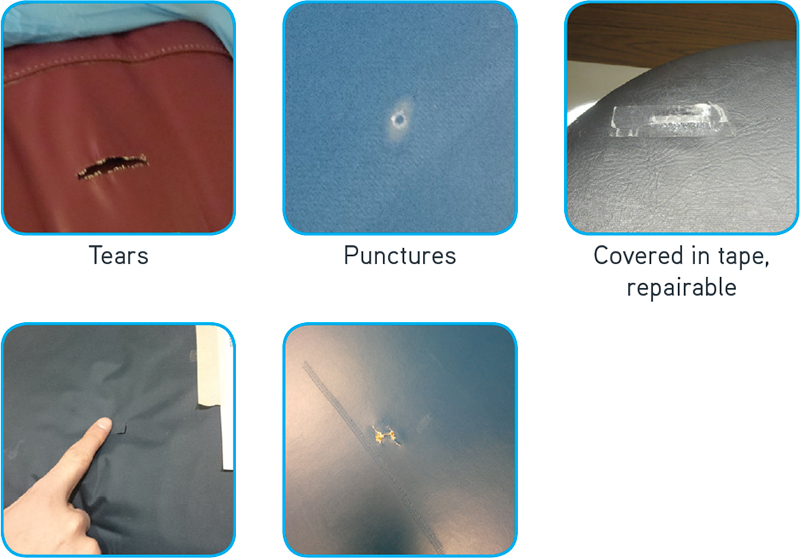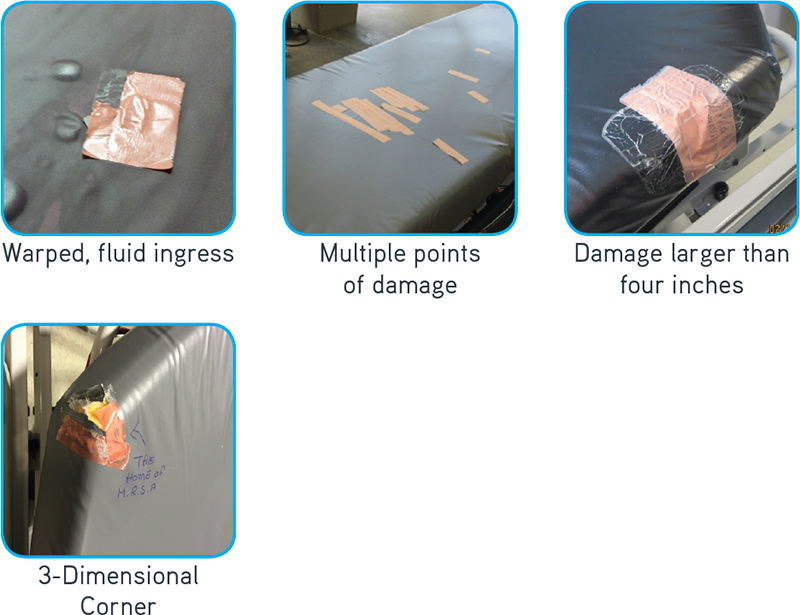Damaged surfaces cannot be properly cleaned and may become a break in the chain of rigorous environmental decontamination. Damaged mattress covers lose their original physical and chemical properties designed to prevent fluid penetration and microbial growth. A study at a U.S. hospital revealed that 26.9% of mattresses on adult medical surgical beds showed occult damage to the interior waterproof backing (Bradbury et al , 2014). In April 2013, the FDA issued a Safety Communication stating that damaged or worn covers for medical bed mattresses can allow blood and bodily fluids to penetrate the mattress, posing a risk of infection to patients.
Many mattresses and stretcher pads are repairable. CleanPatch is a registered FDA Class 1 Medical Device that restores damaged mattresses to an intact and hygienic state. CleanPatch can be used for punctures and tears up to 4” in size. It is important to note the size and amount of damage on the mattress surface when deciding whether to repair with CleanPatch or replace the mattress.
Assess
- Clean the mattress as per hospital protocols and let dry completely.
- Inspect the cover for any rips, tears, punctures or abrasions.
If Damage is noted:
- Look for any signs of warping or staining which could indicate fluid ingress.
- Confirm if any fluid has penetrated to inside foam by folding a Paper Towel into four layers and placing over the torn area.
- Press down with gloved hand to see if any fluid is absorbed by the paper towel.
- If the paper towel shows fluid, the foam core may be contaminated and the mattress should be immediately replaced.
- If there is no fluid, proceed to repair.
Repair

CleanPatch is used only on mattresses that are still considered acceptable within their natural life span and otherwise deemed fit for use.
- CleanPatch should be applied at the earliest discovery of damage, whether it be a tear, rip, puncture, or abrasion.
- Repair of mattresses using CleanPatch should be considered a regular step in the process of cleaning and preparing a bed for a new admission.
- A single damaged area should be completely covered by a single CleanPatch.
- There may be more than one area of damage noted, but each area should be repaired separately. We recommend that a maximum of four to six areas be patched on any given mattress.
Replace

When Not to Use CleanPatch:
- CleanPatch may not adhere properly to certain low friction or coated materials such as Teflon.
- Do not use CleanPatch on mattresses that show signs of fluid ingress or have been contaminated to the inner core.
- CleanPatch should not be applied if the damaged area cannot be fully covered by a single patch. There should be a minimum of 0.5 inch intact margin around the damaged area to ensure that CleanPatch adheres properly. We do not recommend layering multiple patches.
- CleanPatch is most effective on flat surfaces and may not adhere well to corners or three dimensional shapes.
- Do not cut CleanPatch to avoid damaging the precise edge and impacting product integrity.

